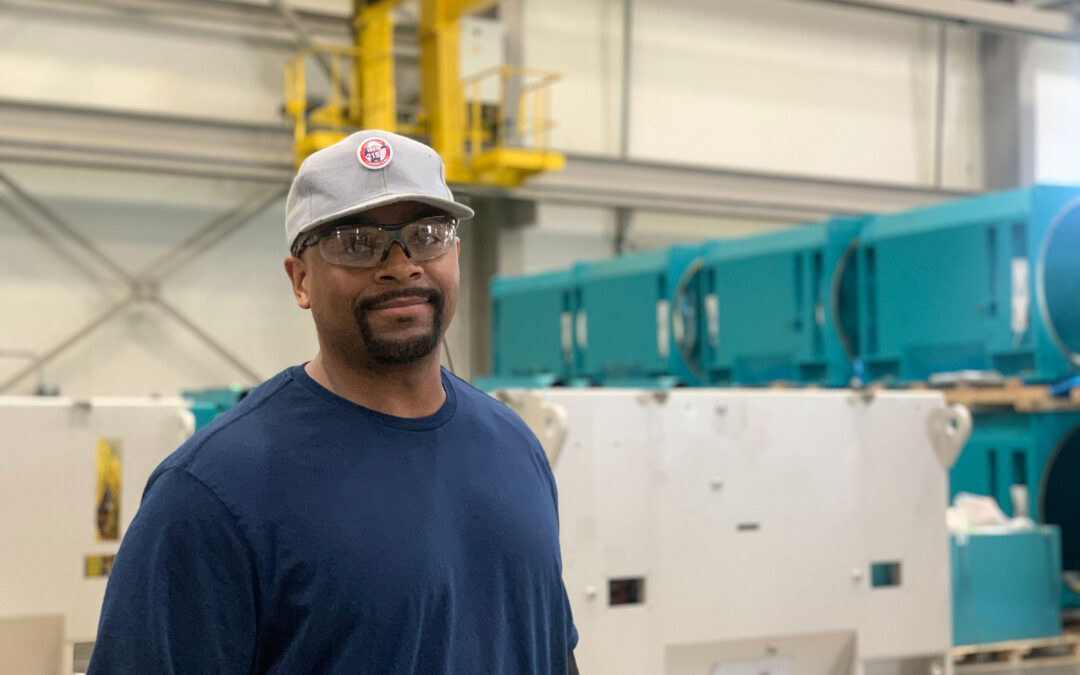
by Jodi Jean Amble | May 17, 2022 | Advocacy, Community, Electric Vehicles, Jobs, Local Initiatives, Renewables, Solar, Wind
RENEW Wisconsin has launched two state-wide communications campaigns to promote the benefits of clean energy investments in Wisconsin. The two campaigns, “Clean Energy Works for Wisconsin” and “Clean Energy is Made in Wisconsin,” include print and digital ads and shareable communications assets for partners and clean energy advocates.
Wisconsin’s clean energy workforce is 70,000 strong, with good-paying local jobs like installing solar and electric vehicle charging stations, manufacturing energy storage systems, servicing wind turbines, and retrofitting buildings. Clean energy job growth is gaining momentum from state and federal clean energy and electric transportation commitments, federal funds to support these goals, and an increased interest in clean energy investments from the public sector. The “Clean Energy Works for Wisconsin” campaign highlights the job potential of continued investment in electric transportation and Wisconsin clean energy.
“Over the next five years, Wisconsin can expect to receive $79 million in federal funds from the bipartisan infrastructure law,” said Francisco Sayu, Emerging Technologies Director at RENEW Wisconsin. “Wisconsin will also have the opportunity to apply for $2.5 billion in competitive grant funding dedicated to electric vehicle corridors and community charging. Building a network of electric vehicle charging stations will reduce emissions, improve air quality, and create thousands of good-paying jobs and is a tremendous opportunity for Wisconsin residents.”
In 2019, Governor Evers set a goal that all electricity consumed in the state will be 100% carbon-free by 2050, and in 2022 introduced Wisconsin’s first-ever Clean Energy Plan. Currently, renewable energy only accounts for 13% of all electricity sold in Wisconsin. According to the U.S. Energy Information Administration, Wisconsin consumes almost six times as much energy as it produces and spends billions on coal, oil, and natural gas every year. The “Clean Energy is Made in Wisconsin” campaign presents a vision of keeping more energy dollars in-state by investing in homegrown renewable energy.
“State and federal investments are moving us toward our clean energy goals, but we need to maximize the benefits of this energy transition for Wisconsin residents,” said Heather Allen, Executive Director at RENEW Wisconsin. “We will need an ‘all of the above’ and ‘all hands on deck’ approach to shape our clean energy future. This means smart investments in homegrown renewable energy and clean transportation.”
Print and digital ads are already circulating in media outlets across the state. To learn more and help amplify Wisconsin’s clean energy opportunities, please visit the “Clean Energy Works for Wisconsin” and “Clean Energy is Made in Wisconsin” landing pages.
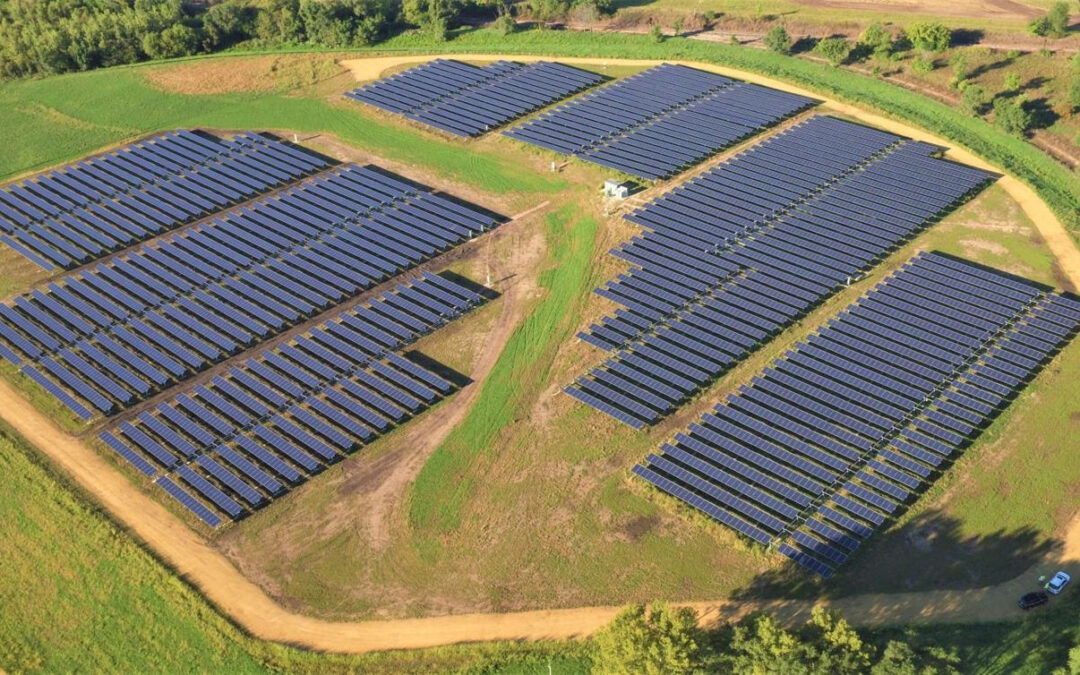
by Michael Vickerman | Apr 28, 2022 | Advocacy, Press Release, PSC Priorities, Solar
But a federal anti-dumping investigation jeopardizes solar power build-out in Wisconsin
Having secured approval today from the Public Service Commission (PSC) to build six more solar power plants, Alliant Energy’s Wisconsin affiliate is on a trajectory to source 20% of its electricity from solar power by 2025.
The PSC decision enables Alliant to construct and operate 414 megawatts (MW) of solar generating capacity in Dodge, Grant, Green, Rock, and Waushara counties. In combination with the 675 MW of projects approved in April 2021, Alliant’s solar power portfolio now consists of a dozen projects totaling more than one gigawatt, or 1,089 MW. Alliant’s approved solar projects are listed in the table below.
Over the last three years, the PSC has approved 1,850 MW of utility-owned solar generating capacity in Wisconsin. Of that total, nearly 60% of that generation will serve Alliant Energy’s Wisconsin customers.
“Today’s approval by the PSC affirms the uniquely valuable set of benefits that large-scale solar will bring to Wisconsin’s power industry,” RENEW Executive Director Heather Allen said. “When placed in service, these 12 solar projects will support the grid long after Alliant retires its coal-fired power plants, generating clean, affordable energy here in Wisconsin while delivering a reliable revenue stream to participating landowners and host communities.”
But a recently initiated U.S. Commerce Department investigation into alleged unfair trade practices has already begun to disrupt utility-scale solar farm development nationwide, including projects in Wisconsin. If not resolved soon, the collateral damage from this investigation will likely spread to the Alliant solar portfolio approved today, causing construction delays and increasing costs.
The investigation, which could extend until August 28th, targets solar products imported from Cambodia, Malaysia, Thailand, and Vietnam. Eighty percent (80%) of all U.S. solar panel imports are sourced from these four countries. If an unfair trade practice is identified, the Commerce Department is empowered to remedy the situation with very high tariffs on panels. For that reason, manufacturers in the targeted countries have been forced to cease production of solar panels destined for U.S. projects.
“Not even a month has gone by, and it is already disrupting solar projects at all stages of the development pipeline,” Allen said. “We are concerned that this investigation can do serious damage to the solar build-out now underway as well as undermine Wisconsin’s Clean Energy Plan.” Allen added: “We ask Senators Baldwin and Johnson and Wisconsin’s Congressional delegation to stand up for Wisconsin jobs, Wisconsin farmers, and Wisconsin’s rural economy and urge the Commerce Department to issue a negative ruling on this matter as soon as possible.”
APPROVED ALLIANT ENERGY SOLAR PROJECTS
| Docket: 6680-CE-183
Approved April 28, 2022 |
| Project name |
Location (county) |
Capacity (in MW) |
| Albany |
Green |
50 |
| Beaver Dam |
Dodge |
50 |
| Cassville |
Grant |
50 |
| Paddock |
Rock |
65 |
| Springfield (Lomira) |
Dodge |
100 |
| Wautoma |
Waushara |
99 |
| Subtotal |
414 |
| Docket: 6680-CE-182
Approved April 21, 2021 |
| Project name |
Location (county) |
Capacity (in MW) |
| Bear Creek |
Richland |
50 |
| Crawfish River |
Jefferson |
75 |
| Grant County |
Grant |
200 |
| North Rock |
Rock |
50 |
| Onion River |
Sheboygan |
150 |
| Wood County |
Wood |
150 |
| Subtotal |
675 |
| Grand total |
1,089 |
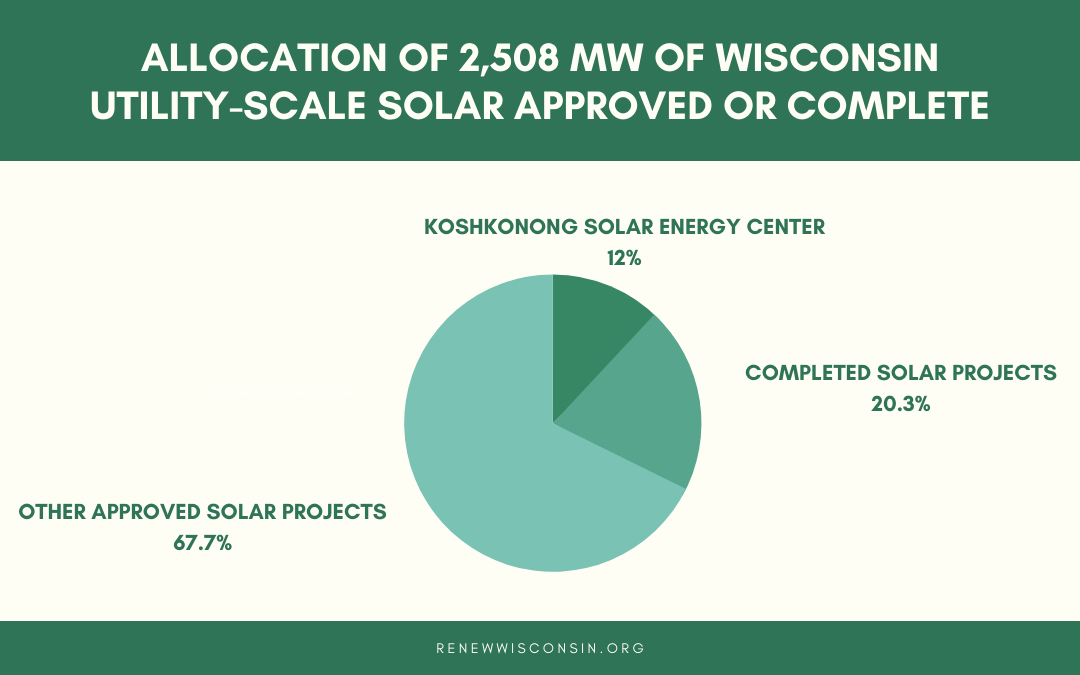
by Heather Allen | Apr 12, 2022 | Energy Storage, PSC Priorities, Public Service Commission, Solar, Utilities, Utility Scale
The Wisconsin Public Service Commission (PSC) approved the construction of the 300-megawatt (MW) Koshkonong Solar Energy Center in early April.
Developed by Chicago-based Invenergy LLC, this solar project will provide enough emission-free electricity to power 60,000 Wisconsin homes. It will become one of Wisconsin’s largest renewable energy generators, representing 12% of Wisconsin utility-scale solar projects that have been completed or approved as of today.
The Koshkonong Solar Energy Center will be located in southeast Dane County. In addition to the 300 MW of solar power, the project will feature a 165 MW battery storage component to help bolster grid reliability. WEC Energy Group and Madison Gas and Electric intend to buy the plant for $649 million.
“This project accelerates the state’s and the region’s transition to clean energy,” said Heather Allen, Executive Director at RENEW Wisconsin. “With enough capacity to provide one-fourth of the local solar needed to meet Dane County’s Climate Action Plan, Koshkonong’s approval is a major milestone in the transition to energy independence for the region.”
When energized, the project will generate $1.2 million per year in new revenue for local governments, in addition to lease payments to local landowners. Construction is expected to begin later this year and will likely become operational in 2025.
“The energy storage component of the project will provide up to 660 megawatt-hours of energy storage per day, or approximately the equivalent battery storage capacity of 6,000 electric vehicles,” Allen added. “Battery energy storage adds more flexibility to the project, allowing for energy use when it is needed most.”
Koshkonong is the fourth solar generation project proposed by Invenergy to receive construction approval from Wisconsin regulators and the third to be combined with an energy storage component. The four solar projects developed by Invenergy—Badger Hollow, Paris, Darien, and now Koshkonong—will comprise 1,050 MW of generating capacity when completed. The energy storage facility at Koshkonong will be the largest of its kind in Wisconsin.
In a separate proceeding, WEC Energy Group and Madison Gas and Electric seek permission to add the Koshkonong Solar Energy Center to their growing portfolio of renewable generating plants. The PSC will likely rule on this application before the end of this year.
In the technical hearing leading up to the PSC’s decision, RENEW provided expert testimony documenting the public benefits to be delivered by the Koshkonong solar and storage project. These benefits include:
- Displacing fossil generation with a zero-carbon source of electricity over its 30-year+ lifetime;
- Providing firm capacity at a Dane County location for replacing the 1,100 MW Columbia coal-fired power plant scheduled for retirement in 2024; and
- Supporting Wisconsin’s farm economy through lease payments to participating landowners and new revenues to local governments hosting the project.
Wisconsin currently has over 510 MW of completed utility-scale solar projects with nearly 2000 MW more approved. This upward trajectory of utility-scale solar projects will help Wisconsin meet its 100% carbon-free goals.
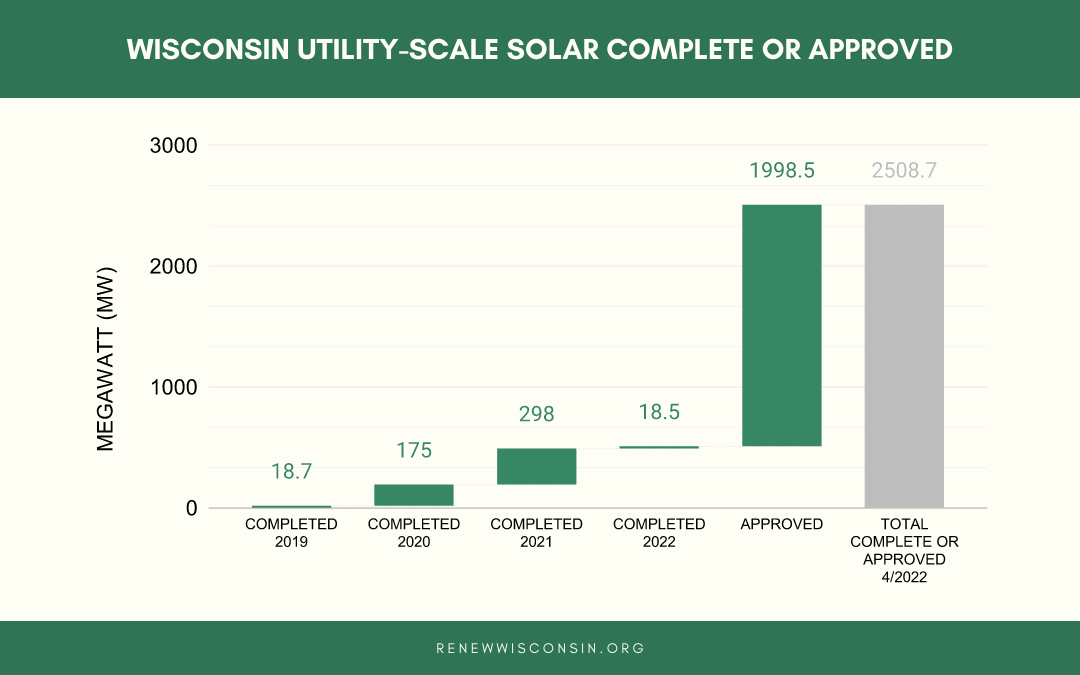
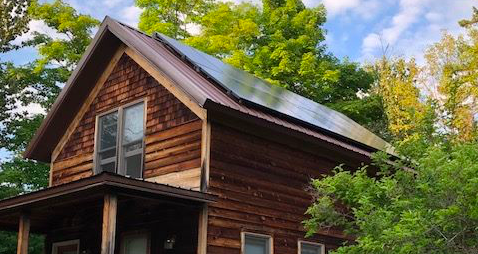
by Heather Allen | Mar 25, 2022 | Advocacy, Net Metering, PSC Priorities, Solar
RENEW Wisconsin, together with a coalition of Clean Energy Advocates (Clean Wisconsin, Environmental Law, and Policy Center, Vote Solar, The Nature Conservancy, Wisconsin Conservation Voters, and the Wisconsin Health Professionals for Climate Action), submitted comments this week to the Public Service Commission in favor of protecting and improving net metering in Wisconsin.
The Commission asked for remarks on four key questions and shared a 60-page memo from the Regulatory Assistance Project describing net metering policy issues, changes to net metering in other states, and several other aspects for consideration. The comment period closed on Tuesday, March 22, 2022.
Wisconsin’s customer-owned solar market is falling behind our neighboring states due to a patchwork of service terms and artificial market barriers. Our coalition comments highlighted several key factors contributing to the issue:
- The absence of a statewide net energy billing policy has fostered an inconsistent and confusing patchwork of tariffs across Wisconsin.

2. Low net energy billing ceilings and low export rates effectively exclude many larger customers from investing in solar systems.
3. Encroachment of utility-owned DG reduces behind-the-meter installation opportunities for customers and solar contractors.
4. The lack of clarity over third-party financing hampers the solar marketplace.
Solar installers, solar customers, clean energy advocates, and climate activists submitted comments echoing these themes. Here are some quotes from the commenters:
“The time has come for the Wisconsin Public Service Commission (WiPSC) to take a customer-centric approach to address the need for dramatic greenhouse gas emission reductions.”
Kerry Beheler and Gary Radloff
Wisconsin GreenFire
“Larger commercial and industrial customers should be allowed to net meter on larger projects that help them displace a greater percentage of their usage with on-site renewable generation. Adjacent states have raised net meter limits above 1000 kW for these customers. State goals of increased renewable energy are efficiently met with an on-site generation that is offsetting load, and this also possibly reduces the need for additional transmission infrastructure. Net metering is one good tool encouraging on-site renewable generation.”
Weselley Slaymaker
“I support a robust net metering policy for Wisconsin. The adaptation of solar power is critical for our energy independence and to mitigate the impact of climate change.”
Megan Stansil
RENEW and its allies explained their priority to improve net metering in the near term to “make net billing tariffs more consistent across Wisconsin utilities.” But we also urged caution that no other reform that could diminish customers’ value proposition for investing in these grid-beneficial technologies should be pursued before reaching much higher solar penetration levels and analyzing the impact of such potential changes.
Net metering is a valuable tool that helps customers generate their energy in a manner that provides both system and public benefits, including carbon emission reduction and economic development. It drives solar deployment and is easily understood and accessible to customers. RENEW will continue to participate in this conversation at the Commission and share results as this process moves forward. Wisconsin can improve customer transparency with a more uniform statewide approach but should be very cautious about risking the benefits of distributed generation by altering rate design.
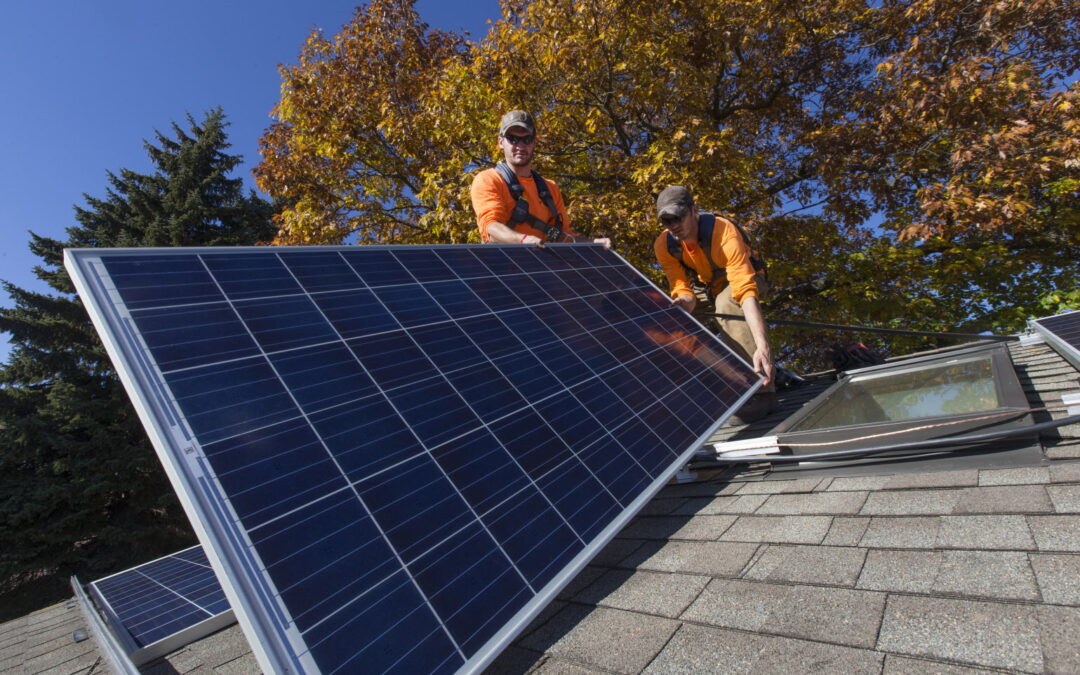
by Sam Dunaiski | Mar 24, 2022 | Local Initiatives, Renewables, Solar, Utilities
On Tuesday, March 22, 2022, the City of Madison and RENEW Wisconsin announced the 2022 MadiSUN residential solar group buy program. MadiSUN is for Madison-area homeowners looking to install solar-electric systems.
In its seventh year, the program offers Dane County homeowners easy access to qualified solar contractors at a competitive price. MadiSUN has spurred approximately $3.5 million in solar energy investments since 2016 and has added over 1,000 kilowatts of renewable electricity to the local electric grid. Over 200 homes in the Madison area have installed solar through the program.
“The MadiSUN program helps make it easy for residents to select an installer and get a cost-effective and high-quality solar system for their home,” said Stacie Reece, Sustainability Program Coordinator for the City of Madison. “Each additional rooftop installation gets us closer to our goal of 100% renewable energy for the City.”
Two local solar installation firms, Arch Solar and Full Spectrum Solar won a competitive bidding process and will design and install arrays for MadiSUN participants. Many solar design firms across Wisconsin anticipate a busy year for installations as Federal Investment Tax Credits begin to wind down in 2023.
“With tax credits at 26%, and utility rates increasing across the state, 2022 is a great year to go solar,” said Stanley Minnick, Head of Sales at Arch Solar, one of the participating contractors for MadiSUN. “This will likely be a record-setting year for residential solar.”
MadiSUN also provides homeowners with multiple options for financing. Loans are available through greenpenny bank and the Clean Energy Credit Union. However, homeowners may choose any financing mechanism they prefer, including home equity lines of credit or loans from other banks.
“Residents of Dane County can count on greenpenny for fast, easy, and affordable financing for their solar projects,” said Jason MacDuff, President of greenpenny. “Our team works hard to find a loan term within our residential solar program that allows for the borrower to trade their current electric bill for a solar financing payment.
In addition to financing and access to local solar contractors, MadiSUN participants have access to additional education sessions, which help them understand the benefits of at-home solar energy.
“Modern solar electric systems are still relatively new technology to many Wisconsin homeowners,” stated Sam Dunaiski, Distributed Resources Director for RENEW Wisconsin and administrator of the MadiSUN program. “The main goal of MadiSUN is to make going solar easy and affordable for any Madison area resident. We want to make sure everyone in the community understands how beneficial solar energy can be.”
Residents can receive a complimentary solar assessment by visiting madisunsolar.com and filling out the “I’m Interested” form. Applications for the Group Buy program must be submitted by August 31, 2022.
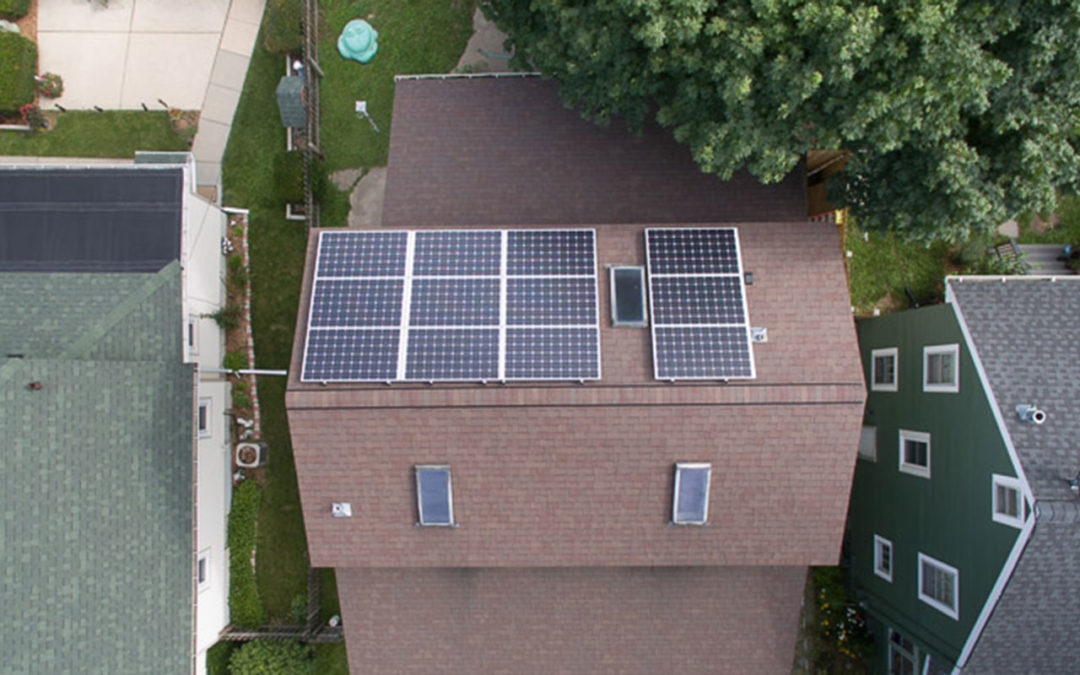
by Andrew Kell | Mar 18, 2022 | Advocacy, Policy, PSC Priorities, Public Service Commission, Solar
In June of 2020, the Public Service Commission of Wisconsin (PSC) opened an investigation into parallel generation (docket 5-EI-157). Parallel generation refers to distributed generation (DG) that is sited at a customer’s premises and can 1) produce energy for the customer’s energy use, and 2) produce and sell to the utility energy that exceeds the customer’s use. The most common type of DG is a solar photovoltaic (PV) rooftop system.
According to the PSC Notice of Investigation, this ongoing parallel generation investigation aims to gather information on costs, markets, emerging technologies, and barriers to DG in the state. A January 2021 RENEW blog described the initial activities in the docket.
After gathering information, the PSC made an initial decision in the docket to further explore:
- avoided costs and buyback rates for DG;
- net metering;
- contracts; and
- consistent terminology and terms of service across the state.
To better understand the value of DG, the PSC directed the five largest investor-owned utilities in Wisconsin to provide modeling and calculations of ‘avoided costs’ and revise the rates at which the utilities purchase energy from DG (also called ‘buyback rates’).
The utility’s buyback rate is a critical economic variable for DG. When homeowners and businesses entertain the idea of solar generation on their rooftops, they must first consider the costs and benefits of installation. The principal economic benefits of installing solar are reducing the energy you buy from the utility and getting paid for the excess energy you sell to the utility. Outside of the net energy billing services available for small installations, most utilities in Wisconsin pay very little for the energy they purchase from DG customers. Utility payments to DG customers don’t recognize the value of local, clean energy, which then oppresses the development of DG and hinders the advancement of carbon reduction goals.
It became apparent that upcoming PSC decisions would reset buyback rates and influence the business case for DG in Wisconsin, potentially for decades to come. As a result, RENEW put together a plan to participate in the utility cases and contracted with GridLab and Synapse Energy Economics to provide expert testimony on the issues.
When the utilities filed their buyback rate applications in early September last year, there were no major surprises to the clean energy community. Rather than model and calculate the long-term avoided costs of local, renewable DG, as the Commission requested, utilities either cited short-term marginal prices for some costs or simply stated that DG provides no value for other costs. RENEW needed to do more than simply critique the utility applications. The RENEW team developed a complete counterproposal for the Commission’s consideration, premised on criteria established by the Commission and just, reasonable buyback rates for DG customers.
Over several months, RENEW collaborated with its consultants and Keyes & Fox, a firm dedicated to clean energy law. Focusing on the Commission’s conceptual framework of avoided energy, generating capacity, and transmission costs, RENEW’s team gathered information, developed and ran market models, and calculated buyback rates. This ensured that RENEW’s proposal would meet the Commission’s requirements and recognize the actual value renewable DG provides to all utility customers.
These efforts resulted in a comprehensive framework for the Commission to consider and adopt for all utilities across Wisconsin. The RENEW team is now submitting testimony and evidence to support this comprehensive framework in all five utility cases.
RENEW now needs your support! The Commission will soon open the public comment period for these five cases and needs to hear from clean energy organizations, climate activists, businesses, and residents across Wisconsin. Below is a list of the five utility cases. RENEW will update the list with dates and direct links to make public comments when the public comment period becomes known. Since Commission decisions in these cases will set a precedent for all utilities in Wisconsin, we encourage you to comment on all 5 cases.
Click on applicable links below to submit comments for each utility.
Energy Policy Nerd Alert!
If you are interested in reading through the details of RENEW’s testimony filings, below are links to direct testimony filings for the case proceeding first (Xcel Energy, aka Northern States Power Company-Wisconsin). Testimony for other cases mentioned above will be available at a later date.
Direct Testimony of Andrew Kell
Direct Testimony of Michael Vickerman
Direct Testimony of Divita Bhandari (Synapse consultant)
Direct Testimony of Rachel Wilson (Synapse consultant)








